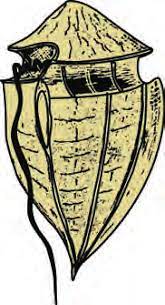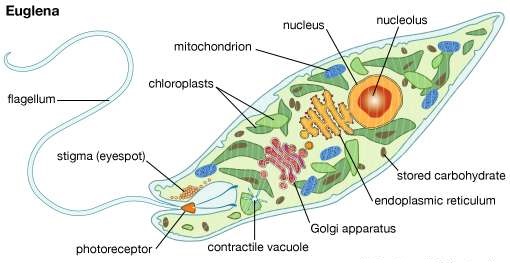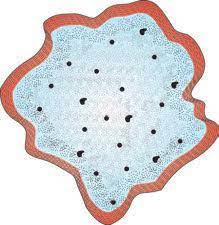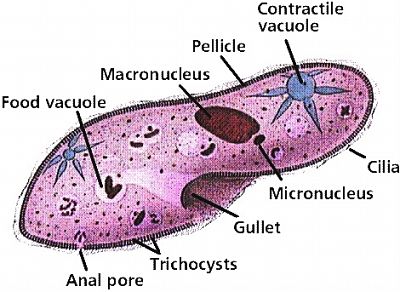
Kingdom Protista
All single-celled eukaryotes come under this kingdom.
Currently, we include Chrysophytes, Dinoflagellates, Euglenoids, Slime molds, and Protozoans under Protista.
Characteristics of members of Kingdom Protista:-
They are primarily aquatic****.
Being eukaryotes, the protistan cell body contains a well-defined nucleus and other membrane-bound organelles.
Some have motile organelles like cilia and flagella.
Protists reproduce asexually and sexually by a process involving cell fusion and zygote formation.
This kingdom forms a link with the others dealing with plants, animals, and fungi.
Chrysophytes:
Characteristics:
They are found in freshwater as well as in marine environments.
They are microscopic and float passively in water currents (plankton)
Most of them are photosynthetic.
Examples: Diatoms and Golden Algae (Desmids).
Diatoms:
The cell walls form two thin overlapping shells, which fit together as in a soap box.
The walls are embedded with silica and thus the walls are indestructible.
They leave behind large amounts of cell wall deposits in their habitat and this accumulation over billions of years is referred to as diatomaceous earth.
This soil is used in polishing, and filtration of oils and syrups since it is gritty.
They are the chief producers of the ocean.
Dinoflagellates:

These organisms are mostly marine and photosynthetic and appear yellow, green, brown, blue, or red depending on the main pigments present in their cells.
The cell wall has stiff cellulose plates on the outer surface.
Most of them have two flagella - one lies longitudinally and the other transversely in a furrow between the wall plates.
Very often, red dinoflagellates undergo such rapid multiplication that they make the sea appear red (red tides).
Toxins released in such large numbers may even kill other marine animals such as fishes.
Example: Gonyaulax (red dinoflagellate).
Euglenoids:

The majority of them are freshwater organisms found in stagnant water.
Instead of a cell wall, they have a protein-rich layer called a pellicle which makes their body flexible.
They have two flagella****, a short and a long one.
Though they are photosynthetic in the presence of sunlight, when deprived of sunlight they behave like heterotrophs by predating on other smaller organisms.
The pigments of euglenoids are identical to those present in higher plants.
Example: Euglena.
Slime Moulds:

They are saprophytic protists.
The body moves along decaying twigs and leaves engulfing organic material.
Under suitable conditions, they form an aggregation called plasmodium which may grow and spread over several feet.
During unfavorable conditions, the plasmodium differentiates and forms fruiting bodies bearing spores at their tips.
These spores possess true walls and are dispersed by air currents.
They are extremely resistant and survive for many years, even under adverse conditions.
Protozoans:

All protozoans are heterotrophs and live as predators or parasites.
They are believed to be primitive relatives of animals.
There are four major groups of protozoans:
Amoeboid Protozoans:
These organisms live in freshwater, seawater, or moist soil.
They move and capture their prey by putting out pseudopodia(false feet).
Marine forms have silica shells on their surface.
Some of them are parasites.
Examples: Amoeba, Entamoeba.
Flagellated protozoans:
The members of this group are either free-living or parasitic.
They have flagella.
The parasitic forms cause diseases such as sleeping sickness.
Examples: Trypanosoma.
Ciliated protozoans:
These are aquatic, actively moving organisms because of the presence of thousands of cilia.
They have a cavity (gullet) that opens to the outside of the cell surface.
The coordinated movement of rows of cilia causes the water laden with food to be steered into the gullet.
Examples: Paramecium.
Sporozoans:
It includes diverse organisms that have an infectious spore-like stage in their life cycle.
The most notorious is Plasmodium (malarial parasite) which causes malaria, a disease that has a staggering effect on the human population.
Kingdom Protista
All single-celled eukaryotes come under this kingdom.
Currently, we include Chrysophytes, Dinoflagellates, Euglenoids, Slime molds, and Protozoans under Protista.
Characteristics of members of Kingdom Protista:-
They are primarily aquatic****.
Being eukaryotes, the protistan cell body contains a well-defined nucleus and other membrane-bound organelles.
Some have motile organelles like cilia and flagella.
Protists reproduce asexually and sexually by a process involving cell fusion and zygote formation.
This kingdom forms a link with the others dealing with plants, animals, and fungi.
Chrysophytes:
Characteristics:
They are found in freshwater as well as in marine environments.
They are microscopic and float passively in water currents (plankton)
Most of them are photosynthetic.
Examples: Diatoms and Golden Algae (Desmids).
Diatoms:
The cell walls form two thin overlapping shells, which fit together as in a soap box.
The walls are embedded with silica and thus the walls are indestructible.
They leave behind large amounts of cell wall deposits in their habitat and this accumulation over billions of years is referred to as diatomaceous earth.
This soil is used in polishing, and filtration of oils and syrups since it is gritty.
They are the chief producers of the ocean.
Dinoflagellates:

These organisms are mostly marine and photosynthetic and appear yellow, green, brown, blue, or red depending on the main pigments present in their cells.
The cell wall has stiff cellulose plates on the outer surface.
Most of them have two flagella - one lies longitudinally and the other transversely in a furrow between the wall plates.
Very often, red dinoflagellates undergo such rapid multiplication that they make the sea appear red (red tides).
Toxins released in such large numbers may even kill other marine animals such as fishes.
Example: Gonyaulax (red dinoflagellate).
Euglenoids:

The majority of them are freshwater organisms found in stagnant water.
Instead of a cell wall, they have a protein-rich layer called a pellicle which makes their body flexible.
They have two flagella****, a short and a long one.
Though they are photosynthetic in the presence of sunlight, when deprived of sunlight they behave like heterotrophs by predating on other smaller organisms.
The pigments of euglenoids are identical to those present in higher plants.
Example: Euglena.
Slime Moulds:

They are saprophytic protists.
The body moves along decaying twigs and leaves engulfing organic material.
Under suitable conditions, they form an aggregation called plasmodium which may grow and spread over several feet.
During unfavorable conditions, the plasmodium differentiates and forms fruiting bodies bearing spores at their tips.
These spores possess true walls and are dispersed by air currents.
They are extremely resistant and survive for many years, even under adverse conditions.
Protozoans:

All protozoans are heterotrophs and live as predators or parasites.
They are believed to be primitive relatives of animals.
There are four major groups of protozoans:
Amoeboid Protozoans:
These organisms live in freshwater, seawater, or moist soil.
They move and capture their prey by putting out pseudopodia(false feet).
Marine forms have silica shells on their surface.
Some of them are parasites.
Examples: Amoeba, Entamoeba.
Flagellated protozoans:
The members of this group are either free-living or parasitic.
They have flagella.
The parasitic forms cause diseases such as sleeping sickness.
Examples: Trypanosoma.
Ciliated protozoans:
These are aquatic, actively moving organisms because of the presence of thousands of cilia.
They have a cavity (gullet) that opens to the outside of the cell surface.
The coordinated movement of rows of cilia causes the water laden with food to be steered into the gullet.
Examples: Paramecium.
Sporozoans:
It includes diverse organisms that have an infectious spore-like stage in their life cycle.
The most notorious is Plasmodium (malarial parasite) which causes malaria, a disease that has a staggering effect on the human population.
 Knowt
Knowt